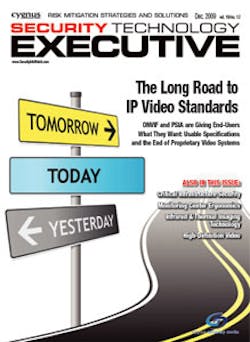In addition to that, and probably most importantly, a number of our members have implemented our video specification. IQinVision, Milestone Systems, Arecont Vision, HikVision, Everfocus, Synectics and Texas Instruments have led the way and there are many more implementations to come. To say the least, it’s been a very busy year.
There are a number of technology standard initiatives building momentum today. As an end-user, you should be aware of these movements and how they will affect you and your technology deployments.
What is PSIA?
PSIA is a global consortium of nearly 50 physical security manufacturers and systems integrators focused on promoting interoperability of IP-enabled security devices across all segments of the industry and developing specifications dedicated to making all IP products interoperable. PSIA is a true open standards organization, as it supports license-free standards and specifications, which are vetted in an open and collaborative manner to the industry as a whole. Since releasing its first open interface, the 1.0 IP Media Device specification in March 2008, more than 700 companies have registered for access to this initial release.
PSIA is doing important work that promises to guide the direction of the security industry. Standards for IP-enabled devices will make the security industry stronger, and ultimately, enable integrators to do their jobs faster, more efficiently, and thus more cost-effectively, and enable end-users to best protect their businesses, people and assets.
How will standards accomplish this? Let’s use IP video as an example. As more camera manufacturers develop IP-ready products, it is imperative they incorporate interoperable standards like the PSIA’s into their product line so their products can communicate with today’s video management solutions like the Milestone platform without the need for a special driver or SDK. But IP video is only one piece of the puzzle. To create a true interoperable security solution — one that includes video, access control, analytics, software, et al. — all products need to support and incorporate standards.
The lack of standards in today’s marketplace has led to difficulty with the integration of IP security solutions. For a particular brand’s camera to work with a another brand’s video management system, manufacturers must build drivers, or APIs, to be able to communicate. The development of these interfaces can take months and can be very costly for manufacturers.
But why and how does that affect end-users? The following are major reasons why standards are a topic you should keep an eye on.
Best-In-Class Solutions
Standards for IP-enabled devices enable end-users to build best-in-class security solutions because proprietary barriers will be a thing if the past. When manufacturers incorporate standards to their product lines, end-users will be able to choose the products, regardless-of-brand, that are best suited for their organization’s specific security needs. Without the barriers of proprietary protocols, security practitioners will be able to build a multi-faceted security solution.
The adoption of standards also provides a higher return on investment, as companies will be able to leverage existing technologies. As additional technologies are added, a security solution will not reach end-of-life. End-users can leverage existing investments over a longer period of time, enabling businesses to migrate to newer technology at their own pace. And as future technology is developed, it can be immediately deployed in real-world applications rather than waiting for manufacturers to develop custom interfaces.
Reducing Upfront and Long-Term Costs
Interoperability between IP-enabled products decreases initial integration costs, because integrators no longer have to spend time integrating disparate technologies. Long-term costs can be minimized as well because existing IP solutions will have the capability to be expanded or modified without the need for costly and time-consuming custom software development.
End-users will also be able to add new and innovative technologies without the need for custom applications and gateways, which often do not support each and every feature that a product might have on its own.
Advanced Products and Features
The growing acceptance of the PSIA standard is expected to increase the rate of product innovation that will enable manufacturers to introduce more advanced models in more market segments. This will be accomplished in a timely and efficient manner as these product providers will be able to avoid delays and effort associated with integration of their products with the wide variety of platforms offered today.
Proactive vs. Reactive
Systems are inherently more intelligent — as they share information seamlessly and offer a higher level of protection because they can provide operators with enhanced situational awareness. This gives end-users access to more critical data, which will enable security departments to operate in a proactive manner. Additional access to critical data will also make security staff more efficient as they are able to respond to potential breaches in a planned manner.
‘This is History in the Making’
The PSIA plugfest at ASIS this year was a key landmark in the progression of standards. Prior to this event, the PSIA specifications had been approved and available, but not tested in a public forum. The interoperability demonstration marked the groundswell of implementations that are becoming available from key security manufacturers, and many more implementations are on their way in 2010. Standards don’t become standards until they are implemented and they interoperate. For PSIA, this is happening now. This is what ‘IP convergence’ is all about.
But the initiative does not end here. We need input from the end-user community in the development process so that we can build specifications that will be most effective to the businesses they are charged with protecting. If you are interested in joining our end-user focus group, please visit www.psialliance.org.
David Bunzel is executive director of the Physical Security Interoperability Alliance, a global consortium of more than 50 physical security providers focused on promoting interoperability of IP-enabled devices in the security industry. For more information, visit www.psialliance.org.

